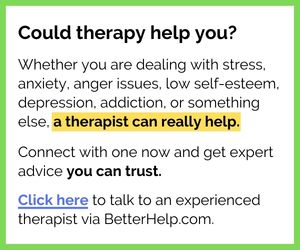Part of being human is having a wide range of different emotions. These emotions can be wonderful at times, offering us the opportunity to experience things like love, elation, excitement, and relief.
There’s a counterbalance to that of course: if we wish to experience these feelings, we also have to feel things like despair, grief, and fear.
Contrary to what most people believe, there are no “positive” or “negative” emotions. Feelings are neutral: they all serve a purpose and are all valid, and thus shouldn’t be labeled as either good or bad.
That said, situations in which being able to control your emotions – even being as emotionless as possible – are very likely to arise.
Important note: if you are trying to be emotionless because you are feeling depressed and just want to feel nothing instead, please do seek professional help using the link above or by speaking to your healthcare provider. Additonally, you may wish to find a support group or charity to help you through your depression. Suppression is not a long-term solution for depression, but the proper treatment can help.
Speak to an accredited and experienced therapist to help you control your emotions but to also work through them when the time is right. You may want to try speaking to one via BetterHelp.com for quality care at its most convenient.
When can it be beneficial to be emotionless?
Any situation that requires calm, clear thinking and action rather than overwhelm and shock can benefit from being emotionless. There are countless examples in which this can be put to use, but these are some of the most likely ones you may encounter:
- Having to help in case of an accident, especially one where someone may need serious medical attention
- Triage situations where you need to assess and then respond to several crises going on at once
- Needing to keep calm and reasonable when someone who’s in a bad state is screaming at you, or threatening others
- Keeping calm and reasoned when a narcissistic abuser or other malicious individual is trying to manipulate you
- Maintaining your composure when explaining a difficult situation to law enforcement, giving evidence in court, or similar
- Keeping your calm when you’re absolutely livid with rage, but you have to keep that tamped down – such as dealing with children, employees, clients, or elders
- If and when you need to take charge in an emergency situation rather than dissolving into panic or hysterics, or if you need to keep someone else from panicking
- If you’re injured and need to remain calm so you don’t pass out or go into shock, or if you need to keep going with what you’re doing despite your own injuries
- When dealing with a sad situation, such as attending a funeral or ending a serious relationship
Those are just a few of the scenarios you may come across that would benefit greatly from the ability to shut down and carry on. We’re no help to anyone if we’re shrieking and snot-bubbling, or wringing our hands in panic about what we’re supposed to do.
Similarly, being able to control emotions can spare everyone a significant amount of grief in the long run. Have you ever flown off the handle when angry and said (or did) things that caused irreparable damage? Words spoken and actions taken when emotions are running high can’t just be “taken back.” The person (or people) you lash out at can’t or won’t forget how you’ve behaved toward them.
Even if your anger was absolutely justified because the situation was truly awful, if you’re in a position where you must set an example, or in which expressing your true feelings will result in permanent damage to your personal relationships, it’s far better to shut all that down.
In times like this, being emotionless is one of the best possible options. Your storm of emotions can be dealt with once everything has settled and the dust has cleared.
Furthermore, if it’s an interpersonal matter that you’re contending with, the outcome will be a lot better and healthier if you can talk it over once you’ve been able to work through and release the kraken roiling within.
Is there a difference between controlling emotions and suppressing them?
Absolutely, yes. The difference between these techniques lies in how we approach them, and what we do with them.
As an example, let’s imagine our emotions as a herd* of agitated ferrets. If we want to control those ferrets, we’ll corral them into a pen where they can be held safely and securely for a while. Then, once the coast is clear and the area is safer for them to roam freely, we can open that pen back up for them.
In contrast, suppressing the ferrets might involve throwing a duvet over them and sitting on them, giving the impression that they don’t exist. That will result in very unhappy, unhealthy, and possibly permanently damaged ferrets who will never be quite right again. You might even destroy some of them in the process, and make a hideous mess while you’re at it.
When it comes to emotions, control vs. suppression works quite similarly.
If you’re controlling your emotions, you’re acknowledging that yes, you have these feelings and they are absolutely valid. You just can’t (or don’t want to) feel them right now, so you’re going to fold them up and set them aside for a little while. In contrast, suppressing those emotions would be akin to pretending that they aren’t there while also stomping on them so they can’t make themselves known.
Controlling your emotions allows you to determine when and how you process those emotions. When you suppress your emotions, however, they’re likely to explode out of you when you least expect it. This includes the possibility of remaining suppressed for years and then suddenly erupting at the dinner table in front of your in-laws.
*Side note: a herd of ferrets is actually called a “business” (or “busy-ness”), just in case that nugget of info is ever needed.
Is it easier (or better) to remain emotionless permanently?
Some people think it’s easier to shut down emotions permanently, especially if they have to deal with stress and heartbreak on a constant basis. After all, it’s human nature to want to avoid experiencing pain, suffering, anxiety, and the like. In fact, just about every living being wants to avoid pain, so it’s completely understandable that the idea of being emotionless might look pretty appealing.
In reality, remaining emotionless can be both devastating and damaging on a long-term basis. This is because turning emotions to the “off” position is fairly easy, but turning them back on again is a different story.
For example, many healthcare professionals struggle with turning their emotions on and off, and this can cause long-term issues in many aspects of their lives. Emergency room nurses who must contend with pain and suffering on a constant basis often find it easier to “switch off” than get overwhelmed. Alternatively, their emotions shut down automatically in a reaction known as “empathy fatigue.“
This can end up damaging their personal relationships, as they won’t be able to feel empathy (or many other emotions) toward their friends, parents, partners, or children. If those around them are upset or hurting, they’ll be efficient, but neither caring nor comforting. Similarly, they might balk from physical affection because to be hugged or kissed might inspire emotions that they don’t want to feel.
People might inadvertently push others away, and even though they might appreciate the silence and solitude temporarily, they’ll undoubtedly feel lost and lonely later on.
Additionally, we have emotions for a wide number of reasons – not just interpersonal relationships. Intuition and discernment are also governed by our emotions. As a result, if we shut ourselves down, we might not have an active “sixth sense” that can keep us from getting into harmful situations, or help us react quickly if we’re faced with imminent danger.
The key then, is to learn how to control your emotions effectively so you can be emotionless when the situation calls for it. Then you can turn them back on again once the coast is clear.
Tips for being emotionless as needed:
The tips mentioned below may help you to go into “emotionless” mode when you need to. Try them out in different combinations to see what works best for you, and don’t hesitate to adapt them to your individual needs. Consider them guidelines or recipes, but alter the ingredients to best suit you.
If you can, practice them in a controlled environment so you have the techniques sorted for when you need them. That way, you can use them as needed to help you through whatever difficulties life may throw at you.
Author’s Note:
Many of these tips are those that I have drawn from personally over the course of my life, and have proven to be startlingly useful. I’ve been in some harrowing situations – some of which I’ve barely survived – and these techniques have served me well while getting through them.
Hopefully they can provide you with some ideas about how to adapt in difficult situations.
1. Focus on regulating your breathing.
When emotions are running high, people tend to take rapid, shallow breaths (hence hyperventilation). This can cause feelings of weakness, dizziness, tingling hands, and an overall sense of unease.
In contrast, deep, slow breathing increases oxygen intake and brings a sense of calm and peace.
Try this exercise:
Breathe in for the count of four, as in each breath measured in the “one, one thousand” of a full second.
Then hold your breath to the count of four, and exhale to the count of eight.
Repeat this at least four times, though you can continue doing it as long as you feel that you need to. This technique will slow down and regulate your heart rate, thus increasing your sense of overall calm.
If you need to interact with and speak to other people while you’re trying to control your breathing, simply bring your attention back to your breath when you can. Try to breathe all the way into your belly as you do so, rather than simply expanding your lungs. This will bring in more oxygen and will also keep your breath from speeding up between interactions.
2. Bring your attention back to your body.
When emotions are running high, we often feel as though we’re partly outside of our own skins. We either spiral out of control, or we feel like we’re partially watching the situation unfold from the sidelines.
The best way to counteract this is to sink back into the body and inhabit it fully.
Are you familiar with the 5-4-3-2-1 senses meditation? It’s an excellent way to focus your attention and control your emotions.
In short, it forces you to bring your attention to your five senses by prompting you to look, touch, listen, smell, and taste certain things.
This takes your attention away from the difficulty that may otherwise overwhelm you and places emphasis on the tangible.
To begin with, you might want to look around you and take note of five blue things you can see. Unless you’re in a room that’s absolutely packed with blue items, it’ll take you a few moments to locate five of them.
Then you work through the other senses in a similar way: 4 different textures or sensations you can feel/touch, 3 distinct sounds you can hear, 2 scents you can smell, and finally a single thing to taste.
You can combine this with the breathing exercise above to bring your attention back to the present moment and get your feelings under control.
3. Shift your emotions into a physical object.
Some people find it helpful to wear or carry a talisman of some sort that they can shift their emotions into when needed. This can be in the form of a stone pendant, a wooden mala bracelet, or even a semiprecious palmstone that they keep in a pocket.
When emotions rise up and threaten to overwhelm, they either hold that object or run it through their hands, and envision themselves drawing said emotions out of their body, and into the stone or wood. Then, once the storm has passed, they allow the emotions back into themselves so they can deal with them.
If you choose to go this route, select an item that’s appealing to you on several levels. Let it be visually appealing so you’re content to carry it with you regularly, and ensure that it has tactile appeal to you as well. You’ll be spending quite a bit of time touching or holding it, so being pleasant-feeling is key.
Finally, make it something that seems natural and unobtrusive to those around you. For example, if you’re Buddhist or Catholic, consider the aforementioned mala beads, or a rosary. Alternatively, you can latch a sturdy tumbled gemstone onto your keychain and tuck that into your pocket. Whatever works best for you!
4. If you have to speak to people, focus on the space between their eyebrows.
Eyes are indeed the windows to the soul, and making eye contact in stressful situations can cause one to lose their composure. Avoiding eye contact in these situations isn’t advisable, especially if you’re negotiating something difficult, standing your ground against someone, or trying to calm down a person who’s in pain or panicking.
Instead of avoiding eye contact entirely, focus on that space between their eyebrows. Simply make sure that you aim for shorter glances rather than staring or holding visual contact. This will make the person feel seen and respected, while also keeping you from losing your cool.
5. Step away from your emotions.
Take a deep breath, and while doing so, imagine that the breath you’re taking is gathering all of your roiling emotions and pulling them backwards like a vacuum. Envision those emotions being pulled out of your back and into a box. See that box closing, then either visualize yourself stepping forward, away from them, or take an actual physical step.
Your ability to take a physical step forward will depend on the situation you find yourself in, of course. This might not be an option if you’re in a small space, or if you must remain seated for various reasons.
If you can’t move your physical body, then envision that box at your back closing down around your emotions, and then pulling them out and away from you.
This is commonly known as “disassociation.” It’s usually seen in a fairly negative light. This is because it often happens as an automatic response to trauma. For example, people often disassociate during physical assault as a way of surviving the damage they’re experiencing. As a result, they might not be able to remember what occurred, or else they’ll have flashbacks about the experience over the next several years.
When it’s done intentionally, however, especially if it’s just temporarily during a crisis situation, it can be an immensely effective way to keep calm and collected until the worst has passed.
Your emotions will be there waiting for you when you’re ready to pick them back up again. But right now, in this moment, they’re tucked into a box on the shelf.
6. Exhale your emotions away from your body.
Another way to move emotions away from your body is to exhale them forward and outward rather than backwards and contained.
You may have noticed that you feel emotions most in your chest and your abdomen. When you take a deep breath, you can envision yourself encapsulating the emotion you don’t want to feel in a bubble.
Then with your next exhalation, see yourself blowing that bubble of emotion away from your body. Each outward breath pushes it further and further away.
You can also use this visualization technique with a cloud or leaf, or anything else that can easily float away from you.
7. Take a deep breath and count to three before saying anything.
This is a technique that’s often taught to teachers and parents so they don’t say something in a moment of anger that they might regret later. We touched upon this earlier when we discussed situations in which being emotionless might be beneficial.
Let’s say you walk in on your small children setting a fire in their bedroom to keep their pet warm. Your immediate response would likely be very, very loud, but that would inevitably end in trauma and subsequent howling from all parties involved. If the fire is small enough that you can take a couple of deep breaths as you put it out and open a window, you’ll allow yourself enough time to set your whirlwind of emotions aside.
You can do what’s necessary to ensure that everything is safe and everyone is free from imminent harm, and then calmly explain to your kids why this was a very, very bad idea indeed. Instead of it being a traumatic experience in which they re-live their parent screaming at them about killing everyone in an inferno, they’ll learn valuable lessons about fire safety.
Keep going with the deep, even breaths as you teach them these lessons, and encourage them to help you undo the awful, dangerous mess that they created.
Once everything is cleaned up, you can go out to the garage and have a few rounds with the punching bag to let the emotions you controlled out again.
8. Keep your voice even and measured.
When we deal with difficult situations, there’s a tendency to speak more quickly, and at a slightly higher pitch than usual. This is akin to hyperventilating, only instead of breathing too quickly and shallowly, we babble.
This might be an attempt to explain things quickly to get the discomfort out of the way as quickly as possible, or it might simply be that panic sets in, and that causes everything to go into hyperdrive.
Think about times in which you’ve had to deal with difficult or uncomfortable situations. Who has held more sway in an argument, or seemed more reasonable and believable: the person who spoke calmly and clearly? Or the one whose voice rose an octave higher than usual and was tripping over their words?
When you modulate your voice to be measured and articulate, you strengthen whatever it is you’re saying. This could be your side of an argument or instructions to those you’re directing, or any other number of things. When you’re calm and clear-spoken, you will be listened to. And heard.
What’s more, by controlling your voice, you control your emotions too. It’s far easier to feel little or nothing when you speak in a way that remains natural and neutral. On the flip side, as soon as you start screaming, your emotions will rise and rise in a self-reinforcing spiral.
9. Maintain neutral facial expressions.
This goes along with the previous tip about modulating your voice to be calm and measured.
In stressful or difficult circumstances, people’s emotions are often mirrored by their facial expressions.
For example, you can tell that someone is afraid if their eyes widen and their mouth opens slightly. Anger often manifests in narrowed eyes, a frown, and a tense jaw. Rapid blinking or lip biting implies nervousness, and a raised lip – even just for a second – can be a microexpression of contempt.
As you can imagine, showing visual cues such as these will allow others to read what it is you’re feeling. If you’re familiar with the concept of a “poker face,” you’ll understand this already. Even a small eyebrow twinge or lip quiver can give away what we’re trying to keep close to our chests.
Children in particular are very good at clueing into these microexpressions. While that level of observation is admirable in the right circumstances, it’s rather counterproductive if you’re trying to keep them calm in the midst of chaos.
They (and the other people around you) will take their cues from how you’re carrying yourself. The same goes for people who might be trying to catch you off guard, encourage you to make a mistake, or manipulate you somehow. They’ll feed off whatever emotions you’re showing.
This is why it’s so important to keep your facial expression as neutral as possible.
Relax the muscles in your brow so your eyebrows remain fairly still, and hood your eyelids slightly like when you’re reading or relaxing. Release any tension around your mouth, and when you’re not speaking, keep your lips together gently. Try to keep your lips closed without clenching your teeth at all, if possible. Doing the latter can make the muscles on the outsides of your jaws ripple, which will imply stress, tension, anger, or fear.
This can actually have a beneficial effect as you’re trying to be emotionless. Quite simply, if you look as though you aren’t feeling fear, anger, sorrow, etc., then you can temporarily trick your mind and body into believing that’s true. It’s kind of like encouraging yourself to be happier by smiling and laughing more.
If those around you see you looking neutral – without fear or any other emotion taking you over – then that will reassure them that everything’s actually okay. They’ll be less likely to freak out or get hysterical if the person they’re looking to for guidance is calm and grounded.
10. Become the eye of the hurricane.
If you’ve ever seen footage of a hurricane or a tornado from above, you’ll recall that there’s always a point of calm right in the center. The winds, rain, and livestock swirling around in the agitated winds might be whirling in all directions, but that epicenter is silent and still.
This is what you’re aiming to become in difficult circumstances. Whatever’s going on around you, let it fly around without disturbing you. Your response to this idea might be that it sounds easy in theory but not necessarily in practice. That’s mostly because techniques on how to do this aren’t taught in Western schools.
Put your attention – and intention – into your feet, and feel an inner weight push downwards to ground yourself. Press your soles and heels into the surface beneath them, full of firm, solid, grounding energy.
Feel yourself drawing from that stillness and strength, as though you’re made of the same substance your feet are resting upon. Become as still and strong as stone, wood, or cement. No matter what’s going on around you, maintain that stillness and inner strength.
Emotions and voices might be roiling and swirling all around you, but they won’t affect you.
This is one of the techniques that can be used for going “gray rock” with a narcissistic abuser. No matter what they throw at you, refuse to react to it. Essentially, your goal is to become the equivalent of a lump of granite. Water and projectiles will crash against you and leave no mark. One can’t injure stone, nor will that stone freak out or cry in a crisis. Mountains like Everest have been standing for millions of years, and aren’t about to crumble when proverbial crap hits the fan.
11. Focus entirely on what’s needed in the moment.
If you’ve sorted out triage – or whatever emergency measure needs to be tended to in this exact moment – then focus everything you have on that. For you, nothing else needs to exist except for what’s needed right here, right now.
Don’t even think about what might happen five minutes from now, nor whatever you’ve seen unfold over the past half hour. Your entire world consists solely on what’s in front of you, or in your hands. That’s what requires your care and attending: everything else can be sorted out later.
Do you need to try to stop a serious wound from bleeding profusely? Never mind what you’re feeling about the situation, as that really doesn’t matter right now. Literally all you need to focus on is applying pressure to the area, and encouraging the wounded person to breathe slowly and regularly.
If you’re dealing with threatening weather like a forest fire, tornado, or snowstorm, determine what’s needed immediately to get everyone to safety, and do that. Make a list of vital supplies and delegate tasks to others so everything is packed quickly and efficiently. Gather people and animals together, ensure that all are accounted for, then move onto the next urgent thing that needs doing.
Don’t allow your thoughts to wander and spiral about all the things that could possibly unfold from this moment onwards. No “what ifs,” no thinking about worst-case scenarios.
Just do what must be done.
12. Allow yourself to feel again once you’re in a safer place to do so.
Life can never be made truly “safe,” but some circumstances are certainly safer than others. For example, if we’re talking about the inclement weather situations as mentioned above, a safer place will be a shelter where you’re unlikely to be sucked up into a cyclone or similar.
Whatever situation you’re dealing with will pass, and you will inevitably end up in a different location. You won’t be in that accident area, courtroom, or confrontational situation forever. You’ll leave the area or make your way to a place where you’re more comfortable and less likely to have to deal with additional stressors.
Then, once the maelstrom has calmed, injuries have been tended to, and risk of burning to death has been neutralized, it’s important to unpack the emotions that you’ve set aside. Otherwise, you’ll risk crashing from adrenal fatigue or otherwise being overwhelmed.
If you don’t feel comfortable with showing emotions in front of other people, take some time to yourself to work through them. Physical exercise like a run or a long walk can help to release the nervous tension that’s built up in your back and legs. This is from the natural “fight or flight” response to stress. When you have to be emotionless for a while to get through difficulty, that tight adrenal reaction lingers and increases until it’s released.
Once you’ve had some exercise, consider taking a long shower. The sensation of water pouring down over your body can help to release the stored-up emotion you’ve been carrying with you. Additionally, showers are ideal for drowning out sound if you want to have a good cry while you’re in there.
Why is it important not to remain emotionless permanently?
As mentioned earlier, having emotions is part of what makes us human. Without them, we don’t have the ability to truly feel love, joy, or friendship. Sure, it might be easier to avoid feeling fear or grief, but when you turn off the taps, so to speak, you shut off access to all emotions: it’s not selective.
Furthermore, when we keep stormy or difficult emotions suppressed (or repressed), they don’t actually disappear. They’re still there, but they’ve been stuffed into the closet rather than being dealt with. As you continue to bundle up emotions you don’t want to deal with, those get shoved into that closet too.
Before you know it, there isn’t enough room to store any more, and the ones already crammed in there are pushing against the door. They’re poised to explode outward at any given moment, which will undoubtedly be a rather explosive situation.
It’s far better to pull those boxes out a few at a time and go through them in a controlled manner than risk that explosion happening when you least want it to. Having a nervous breakdown or psychotic episode at work or at a public event can be excruciating, for example.
Furthermore, holding all these emotions back instead of processing them in a healthy way can result in long-term emotional imbalance. Conditions such as complex post-traumatic stress disorder (C-PTSD) can arise from not being able to work through emotions in a healthy, timely way.[1]
When to ask for help.
One common problem that can arise from being emotionless for a period of time is the inability to switch those emotions back on. You might find yourself unable to feel compassion or empathy for those who are suffering, or irritation with people who are being “overly emotional.”
Additionally, you may discover that you feel generally “grayed-out” – things you used to enjoy now don’t bring you any happiness or excitement, even if you want them to. You don’t look forward to anything, and feel general apathy about the goings-on in other people’s lives.
It’s possible that you’ll discover that you don’t feel the same way about people anymore. You might know that rationally, you love these people dearly and want to spend time with them, but the wealth and depth of emotion that you used to feel just doesn’t seem to be there anymore. Instead, there’s more of a beige numbness where your feelings used to be.
Other issues that can arise may include short- and long-term memory gaps, dizziness, anxiety, unexplainable agitation, digestive problems, and sleep disturbances. You might even feel like you’re in a waking dream, and that what’s going on around you doesn’t really feel “real.”
This means that you’ve been so effective at becoming emotionless when you’ve needed to that there’s been a glitch when you want to turn those emotions back on. Consider this rather like a circuit breaker for your feelings. You’ve had to shut down that particular circuit in order to do some work, but when you try to shift it back on, it catches.
If this occurs, then you’ll likely need some help turning that circuit back on again. In a case like this, a therapist is the equivalent of a master electrician. They’ll be able to trace the issue back to its source and give you the tools you’ll need to get power running through smoothly again.
When this happens, you can expect there to be a surge of emotions that come forth, and that’s absolutely normal. Please don’t give yourself a hard time if you break down in tears or get waves of extreme anger or fear. Once those waves have passed, everything will be considerably calmer.
Furthermore, you’ll have some new skills in your coping mechanism repertoire: not only will you be able to be emotionless when the situation calls for it – you’ll also be able to turn those emotions back on again when you’re ready to do so. Both of those skills are invaluable, and you’ll be able to pass those abilities onto others in turn.
So, yeah, get yourself a therapist both to help you control your emotions and also to turn them back on after the event has passed and you no longer need to be so calm or measured.
BetterHelp.com is a website where you can connect with a therapist via phone, video, or instant message.
While you may try to work through this yourself, it may be a bigger issue than self-help can address. And if it is affecting your mental well-being, relationships, or life in general, it is a significant thing that needs to be resolved.
Too many people try to muddle through and do their best to overcome issues that they never really get to grips with. If it’s at all possible in your circumstances, therapy is 100% the best way forward.
Click here if you’d like to learn more about the service BetterHelp.com provide and the process of getting started.
You’ve already taken the first step just by searching for and reading this article. The worst thing you can do right now is nothing. The best thing is to speak to a therapist. The next best thing is to implement everything you’ve learned in this article by yourself. The choice is yours.
You may also like:
- 10 Ways To Control Your Emotions In The Moment (+ 7 In The Long Term)
- Emotional Flooding: What It Is, Symptoms, Dealing With It
- 10 Ways To Respond, Not React, In Moments Of Stress
- Emotional Triggers: How To Identify, Understand, And Deal With Yours
- 20 Healthy Coping Skills: Strategies To Help With Negative Emotions
- 12 Radical Acceptance Coping Statements To Deal With Difficult Emotions
- How To Calm Down When You’re Really Really Angry (+ 7 Things NOT To Do)
- Why Do I Cry When I Get Mad? And What Can I Do To Stop?
- 13 Little Signs You’re Emotionally Constipated
- 10 Harmful Effects Of Bottling Up Your Emotions (+ How To Stop)
References:
- Powers A, Cross D, Fani N, Bradley B: PTSD, emotion dysregulation, and dissociative symptoms in a highly traumatized sample. J Psychiatr Res. 2015 Feb;61:174-9. doi: 10.1016/j.jpsychires.2014.12.011. Epub 2014 Dec 23. PMID: 25573648; PMCID: PMC4308496











